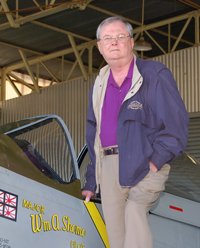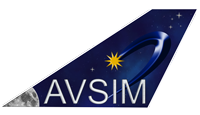Review by Roger Curtiss. I have evaluated a few airport sceneries over the years and with only a couple of exceptions they have all been airports to which I have actually traveled. I felt that having this real world reference would provide some insight into gauging the effectiveness of the scenery reproduction.
However, the airport at Charlotte, North Carolina is not one with which I am familiar. I am aware that it has for quite a while been a hub for US Airways, but I never flew an airline to or from that airport, and my virtual flight record indicates that I have not flown there for at least the last five years of simulation flying.
Therefore, I had to approach the review of Imaginesim’s KCLT with a different frame of mind. Rather than be able to determine if the airport is a true and accurate rendering of its namesake, I instead took a more objective view of what features the scenery offered and how the presentation looked and felt as representative of a major commercial airport.
A distinction I could make was to differentiate the Imaginesim version from the default FSX KCLT. One factor that was immediately apparent was that the FSX variety only depicts three runways at the airport 36L/18R, 36R/18L and 5/23. The present day KCLT has an additional runway, a 9000’ 36L/18R to the west of the older runways (the old 36L/18R is now 36C/18C) and ImagineSim includes that configuration.
 Default top down view |  ImagineSim Top down view |
Installation
The scenery is a 54.4MB download expanding to 73MB once on the hard drive. The installation documentation recommends that the user run and close FSX before installing in order to assure a “fresh start”, error-free FSX configuration. It is difficult to say whether this step is truly necessary, but since it is relatively easy to do, why not?
Actual installation requires input of a registration key and execution is rather quick. Once in place, a new folder is created containing a .cfg file, manual, and scenery and texture sub-folders. The install also provides AI mapping in the setup to facilitate integration of AI aircraft for those simmers not inclined to be online.
Once successfully installed, the scenery seamlessly replaces the default airport and the difference is immediately noticeable if no other reasons than the existence of numerous airport ground vehicles with flashing roof lights and the very welcome presence of signs designating each gate location. If the scenery causes a frame rate hit, the numerous airport vehicles can be removed by deleting a line in the .cfg file. The gains in the airport environment are offset by one small loss- the scenery does not make provision for moving jet ways so your virtual passengers will have to venture outside in order to board and disembark.
Included is a 12-page manual detailing system requirements, optimum FSX settings, airport diagram, explanation of the docking guidance system and FAQs.
The Details
Imaginesim uses a standardized description on its website for each of its airport sceneries touting such features as custom-made runways, an interactive docking system, taxiways with highly realistic concrete textures, full airport taxiway and runway signage, 3D approach lighting and full ILS navigation, hundreds of vehicles and ground personnel, and a perimeter fence with security cameras. Once the sun goes down the scenery promises that it “looks stunning after dark with beautifully lit buildings and parking areas” and “complete taxiway and runway lighting”.
So, using Imaginesim’s own descriptors, how does this scenery match with the promise?
Custom-made runways
The runways do exhibit some individual characteristics that differentiate them. While 36L and 36C appear to be concrete, the tire marks on them are not identical. Runway 36R appears as concrete south of the touchdown zone but then has a much darker asphalt appearance for the remaining majority of its surface.
 36L texture |  36C texture |  36R texture |
Interactive Docking System
The docking guidance system for each gate consists of a box with dual visual signals. On the left side is a traffic light providing continue/stop indications via standard traffic signal lighting. To the right of that are two neon tubes. The left tube serves as a lateral guidance and speed indicator. As the tube lengthens aircraft speed should be reduced. In combination with the right tube, this also provides lateral adjustment cues via red and green indicators. Simply steer toward the green tube to regain proper alignment. It is a rather intuitive and effective system.
 Docking guidance. Centered and moving in |  Left correction needed |
 Just about at the stop point |  Stop |
Taxiways with highly realistic concrete textures
I visited the website of the actual KCLT and learned of a relatively recent construction project-an extension of taxiway D 2400’ south to the end of 36R. That project took a year and was completed in September 2013. This additional taxiway is not included in the scenery and in fact, the scenery lacks quite a few signs on taxiway D at various intersections. It would be nice if perhaps at some point Imaginesim could revisit KCLT with an update that extends taxiway D to the approach end of 36R so that general aviation and Air Guard aircraft will not have to cross the runway in order to taxi to that runway end.
 KCLT diagram included with the scenery package |  Current airport diagram depicting south extension of taxiway D to 36R |
Full airport taxiway and runway signage
It seemed odd to me that none of the taxiways leading away from the runways have signs visible from the runway indicating their designation.
There also seem to be taxiway signs and/or markings missing from two intersection areas on the airport that the Airport Diagram for KCLT designates as HS-1 (Hot Spot-1) and HS-2. The explanation for HS-1 states, “Confusing intersection due to convergence of Twy R, Twy A, Twy C and Twy C9, along with a grass island.” Indeed, it is a confusing area, made even more so by the lack of a sign on taxiway C at R.
The explanation for HS-2 states, “Pilots exiting Rwy 18C–36C on Twy S for either
Twy E or Twy F mistakenly turn left on Twy E5 and reenter the rwy.” I can see how that can happen as there is no taxiway centerline indicating the turn from taxiway S to E.
I also noted a few differences in signage from the default scenery; such as in the newer version there is no designation of taxiway F along the west side of the terminal ramp north of taxiway B and E14. Also, older airport diagrams depict eight numbered holding spots around the perimeter of the ramp area. These painted circles are present in the scenery (actually, the scenery shows 11 of them -1 thru 4 and 6-12...5 is missing) but current KCLT diagrams do not show them anymore.
Ramp Metering Spot
I emailed Imaginesim using the support contact address on their website and inquired about the signs. I received a timely and interesting response explaining that the Imaginesim crew is based in the UK and hyper-concerns of enhanced US security measures prevents non-US citizens from obtaining the needed airport access to perform a complete surface analysis. Therefore, they must rely on satellite and aerial photography to conduct their mapping. The upshot of this is that if a detail does not appear in the imagery, it does not get modeled in their products.
The newest runway 18R/36L was built west of the previous runway complex and the two access taxiways to that runway (taxiways N and S) are shown on the diagram to be on short bridges just east of taxiway W. The airport scenery does not replicate those elevations-the surrounding terrain appears to be flat.
3D approach lighting and full ILS navigation
The approach and runway lighting are very bright…perhaps even a bit excessive. The approach lights would be even more impressive if they had moving “rabbit” lead in lights on the single row.
 Powerful approach lights |  Short Final |  Touchdown zone |
Hundreds of vehicles and ground personnel
Certainly no argument here. Part of what brings the airport alive is the presence of so many vehicles most of which have flashing amber roof lights. There is also an abundance of parked vehicles located in various parking lots and behind buildings. The terminal area is especially well done with some gates fully stocked with service vehicles, some empty for a very realistic feel. There are also various cargo bins, carts, and service stairs parked all around the airport. What I did not find, even with sliders maxed out, were any personnel.
 Default view east from Gate 1 |  View east from Gate A1 with added vehicles |  Very realistic looking Avis building and parking lot |
Perimeter fence with security cameras
Indeed, the airport property is fully surrounded by fencing. I was not able to locate any security cameras, but then again, I wasn’t looking all that hard for them either.
Beautifully lit buildings and parking areas
Terminal lighting and other building illumination is slightly subdued and while there are plenty of light poles with floodlights, those lights do not actually project any spot beams to the pavement, they merely have a white texture indicating that they are lit.
C gates night lighting. It would be better if the light poles actually generated some light.
Complete taxiway and runway lighting
The runways and taxiways are well defined for night use. Taxiways have green centerline lighting so maneuvering about the surface is easily executed. The runway lights and the centerline lights are so intense as to have a tendency to flare. I suppose it might be possible for someone with the proper knowledge to go into a .cfg file and tone down the light intensity a bit. I looked in the scenery folders and all that are there are .bgl files and of those it was not readily clear which dealt with approach lighting…to say nothing of the fact that I have no clue as to how to change them anyway.
Lighting and signs very readable at night
Certainly, I am nitpicking in spots here and the casual observer might not notice some of these fine points. And despite what might be interpreted as a perceived lack of perfection, this rendition of KCLT greatly enhances the airport, giving it a much more realistic feel that is well worth the cost.
 Default 36L north to terminal |  36C north to terminal |
 Default ANG ramp |  ANG ramp |  Default GA ramp |
 GA Ramp |  Default cargo ramp |  Cargo Ramp |
 Default Gate A1 |  Gate A1 |  Default aerial view of terminal |
 Aerial terminal view |  Default maintenance hangar |  Cargo ramp with American hangar sporting new logo |
 Default C gates |  C gates |  Default LF view from A1 |
 View from LF A1 |  Default aerial GA ANC ramps |  Aerial GA ANC ramps |
Whether every sign is accurate or every detail matches the actual is almost beside the point. After all, airports are rarely static entities, their configurations are changed and scenery developers can hardly be expected to keep up with every single one. That being said, however, I will reiterate that if Imaginesim were to revisit KCLT the addition of the taxiway D extension south would be a most welcome addition. In fact, I contacted them suggesting that and received a reply that my observation would be passed on to the design team for consideration.
I very rarely make use of AI traffic (preferring to do my flying online) but I switched off Squawkbox and pushed my traffic sliders full right. The airport area filled up with traffic- general aviation first and within a few minutes a variety of airliners as well. Strangely, however, none of the airline aircraft utilized the terminal gates. Any that were parked were on the ANG ramp and they taxied from there to 36R for departure.
The many features provided do come with a small tradeoff. In order for all of them to load, the airport can take a while to be fully formed. While a few miles out, the airport ground appears as an open area with vague outlines of runways. As one gets closer, the forms take on increasing definition and are fully rendered prior to the final approach phase. While this makes the airport a bit difficult to recognize at first, it is preferable to having the scene pause in order to load which can cause problems when online.
 It takes a while to load the scenery |  The end of the runway is just visible as being formed |
Summary
This scenery may not be a perfect offering, but its few faults are easily eclipsed by the added sense of realism it provides and at US$28.99, it is not very expensive. As I stated earlier, the mere fact that each gate sports an identifying sign justifies the price as far as I am concerned. That surface textures, lighting, and other details are added just serves to seal the deal.
Imaginesim has developed a reputation for producing solid products and KCLT is no exception.
Test System Used
- HP Dual Core computer
- Intel i7 2600 processor
- 3.4 GHz
- 9 GB RAM
- Windows 7 Home Premium 64 OS
- Nvidia GeForce GTX580 video card








Recommended Comments
There are no comments to display.
Create an account or sign in to comment
You need to be a member in order to leave a comment
Create an account
Sign up for a new account in our community. It's easy!
Register a new accountSign in
Already have an account? Sign in here.
Sign In Now